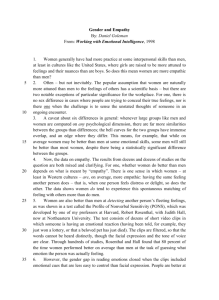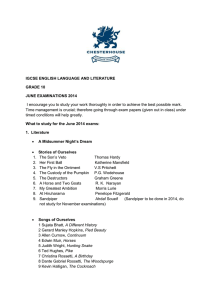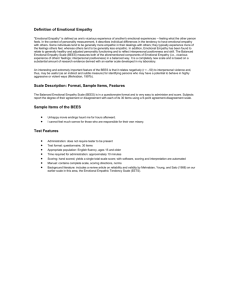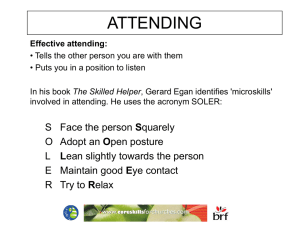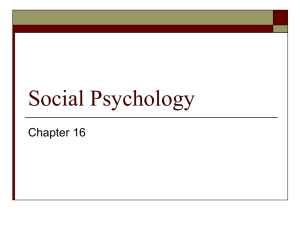Document 10465735
advertisement
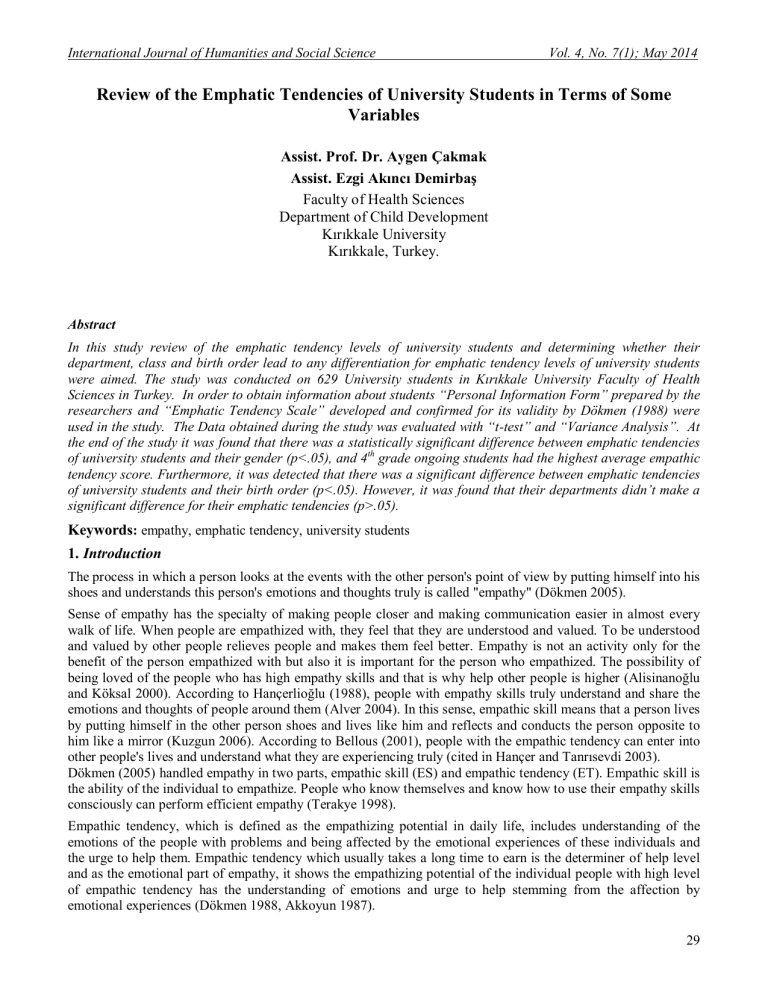
International Journal of Humanities and Social Science Vol. 4, No. 7(1); May 2014 Review of the Emphatic Tendencies of University Students in Terms of Some Variables Assist. Prof. Dr. Aygen Çakmak Assist. Ezgi Akıncı Demirbaş Faculty of Health Sciences Department of Child Development Kırıkkale University Kırıkkale, Turkey. Abstract In this study review of the emphatic tendency levels of university students and determining whether their department, class and birth order lead to any differentiation for emphatic tendency levels of university students were aimed. The study was conducted on 629 University students in Kırıkkale University Faculty of Health Sciences in Turkey. In order to obtain information about students “Personal Information Form” prepared by the researchers and “Emphatic Tendency Scale” developed and confirmed for its validity by Dökmen (1988) were used in the study. The Data obtained during the study was evaluated with “t-test” and “Variance Analysis”. At the end of the study it was found that there was a statistically significant difference between emphatic tendencies of university students and their gender (p<.05), and 4th grade ongoing students had the highest average empathic tendency score. Furthermore, it was detected that there was a significant difference between emphatic tendencies of university students and their birth order (p<.05). However, it was found that their departments didn’t make a significant difference for their emphatic tendencies (p>.05). Keywords: empathy, emphatic tendency, university students 1. Introduction The process in which a person looks at the events with the other person's point of view by putting himself into his shoes and understands this person's emotions and thoughts truly is called "empathy" (Dökmen 2005). Sense of empathy has the specialty of making people closer and making communication easier in almost every walk of life. When people are empathized with, they feel that they are understood and valued. To be understood and valued by other people relieves people and makes them feel better. Empathy is not an activity only for the benefit of the person empathized with but also it is important for the person who empathized. The possibility of being loved of the people who has high empathy skills and that is why help other people is higher (Alisinanoğlu and Köksal 2000). According to Hançerlioğlu (1988), people with empathy skills truly understand and share the emotions and thoughts of people around them (Alver 2004). In this sense, empathic skill means that a person lives by putting himself in the other person shoes and lives like him and reflects and conducts the person opposite to him like a mirror (Kuzgun 2006). According to Bellous (2001), people with the empathic tendency can enter into other people's lives and understand what they are experiencing truly (cited in Hançer and Tanrısevdi 2003). Dökmen (2005) handled empathy in two parts, empathic skill (ES) and empathic tendency (ET). Empathic skill is the ability of the individual to empathize. People who know themselves and know how to use their empathy skills consciously can perform efficient empathy (Terakye 1998). Empathic tendency, which is defined as the empathizing potential in daily life, includes understanding of the emotions of the people with problems and being affected by the emotional experiences of these individuals and the urge to help them. Empathic tendency which usually takes a long time to earn is the determiner of help level and as the emotional part of empathy, it shows the empathizing potential of the individual people with high level of empathic tendency has the understanding of emotions and urge to help stemming from the affection by emotional experiences (Dökmen 1988, Akkoyun 1987). 29 © Center for Promoting Ideas, USA www.ijhssnet.com Rogers (1983) defined "empathic tendency" as social sensitivity. He also expressed that social sensitivity is a personality trait which everybody does not have and individuals with social sensitivity can be more empathic and can learn empathy easily (Öz 1998). Researchs showed that university students with high level of empathic tendency are more sensitive to the social issues compared to the students with low level of empathic tendency and people with high level of empathic skill and tendency have higher level of communication with their surroundings (Ataşalar 1996, Seymen 2007). In this research, starting from the importance of determining empathic tendency levels of university students who will work in health sector, educating them about the importance of empathy and developing empathy skills, it is aimed to assess the empathic tendency levels of students from the departments of Child Development, Physical Therapy and Rehabilitation, Nursing and Health Administration in the Faculty of Health Sciences in Kırıkkale University. 2. Material and Method This research was carried out with the aim of analyzing empathy tendency levels of university students and identifying whether their sexes, departments they are studying at currently, grades and birth orders cause any differences. Research was conducted with 629 university students studying in the Department of Health Sciences in Kırıkkale University located in Kırıkkale city center. In this research, a Personal Information Form prepared by researchers and Empathy Tendency Scale (ETS) prepared and tested by Dökmen (1988) in terms of reliability and credibility were used as data collection tools. This likert scale was developed by Dökmen (1988) with the aim of measuring individuals' empathizing levels in daily life and it consists of 20 question each of which is scored between 1 and 5. While adding the scores together, 3., 6., 7., 8., 11., 12., 13., 15.questions are added reversely. The lowest scale score is 20 while the highest one is 100. The total score represents the participants' empathic tendency scores and high scores show high level of empathic tendency while low scores show low level of empathic tendency. ETS reliability was proven by Dökmen (1988) with the test-retest method by applying this scale on a 70-student group in every 3 weeks. As the conclusion of this analysis, reliability of this scale was found as .82. Independent variables of this research are the defining characteristics of students. In the analysis of data, t-test and one-way analysis of variance were used and p<.05 was accepted as significant (Büyüköztürk 2002). 3. Findings and Discussion Table 1: T-Test Results on Average Scores of Empathic Tendency According to Sexes of University Students Sex Female Male *p<.05 N 499 130 X 70.85 68.49 SS 8.30 8.57 t 2,862 p .004* When Table 1 is analyzed, it can be seen that average score of empathic tendency of females (x =70.85) is higher compared to males' (x =68.49). According to the analysis result, there is a significant difference between empathic tendency of university students and sexes (P<.05). In his research where he analyzed the level of empathic tendency of second grade primary school students, Rehber (2007) found out that females have higher level of empathic tendency when compared to males. Girls and boys are going through different socialization processes due to the community and culture they are living in since these socialization processes attribute different gender roles to girls and boys, girls are thought as more emotional and more sensitive in empathy. 30 International Journal of Humanities and Social Science Vol. 4, No. 7(1); May 2014 Table 2: Average Scores, Standard Deviations and Results of Variance Analysis Regarding Empathic Tendency of University Students According to the Departments Department Child Development Physical Therapy and Rehabilitation Nursing Health Administration Total Variance Analysis Results Between-Groups Within-Group Total N 159 153 179 138 629 SD 3 625 628 Average Scores Regarding Empathic Tendency 71.54 ± 8.01 70.15 ± 8.24 Sum of Squares 437.472 43917.606 69.30 ± 8.47 70.61 ± 8.88 70.36 ± 8.40 F 2.075 P .102 *p<.05 When Table 2 is analyzed, it can be seen that university students studying at the department of Child Development have the highest empathic tendency score averages (x = 71.54) while students studying at the Nursing department have the lowest (x = 69.30). As the result of variance analysis, it was found that there is not a significant difference between university students' empathic tendency and the departments they are studying at (p>.05). In his research with the students at the nursing department, Yaşar (1993) identified no significant difference between empathic tendency scores of nurses. In his research where he analyzed empathic tendency of university students who are prospective teachers and studying at different programs, Sayın (2003) identified no significant difference between the levels of empathic tendency of students according to the departments they are studying at. Main philosophy of health services is aiming to help. In the education process, communication courses as well as other courses and practices are assumed to contribute to the improvement of students' communication skills. Table 3: Average Scores, Standard Deviations and Results of Variance Analysis Regarding Empathic Tendency of University Students According to Their Grades Grade 1. grade 2. grade 3. grade 4. grade Total Variance Analysis Results Between-Groups Within-Groups N 209 170 144 106 629 SD 3 625 Total 628 Average Scores Regarding Empathic Tendency 69.56 ± 8.31 70.79 ± 7.76 69.40 ± 8.58 72.56 ± 8.96 70.36 ± 8.40 Sum of Squares F P 811.184 3.881 .009* 43543.894 4-1 4-3 4-2 *p<.05 When Table 3 is analyzed, it can be seen that 4.grade students have the highest empathic tendency score averages (72.56 ± 8.96), while 3.grade students have the lowest (69.40 ± 8.58). As the result of variance analysis, it was found that there is a significant difference between empathic tendency and grades of university students [F (3625) = 3.881, p<.05] and this difference is caused by 4.grade students. In their research where they analyzed empathic skill levels of prospective pre-school teachers, Akyol and Çiftçibaşı (2005) found out that there is a significant difference between empathic skills of first, second, third and fourth grade students according to their grades and empathic skills of prospective teachers’ increases as the grade level advances. 31 © Center for Promoting Ideas, USA www.ijhssnet.com 4. grade students high level of empathic tendency gives rise to the thought that their course intensity during four years both in general and occupational grades increased their chances to practice empathy in application areas and to know and internalize their occupation better. Table 4: Average Scores, Standard Deviations and Results of Variance Analysis Regarding Empathic Tendency of University Students According to Their Birth Order Birth order First-born Middle sibling or one of the middle siblings The youngest sibling Total Variance Analysis Results Between-Groups Within-Group N 262 211 Average Scores Regarding Empathic Tendency 70.93 ± 8.49 70.73 ± 8.32 156 629 SD 2 626 68.92 ± 8.24 70.36 ± 8.40 F 3.118 Total 628 Sum of Squares 437.482 43917.596 P .045* 3-1 3-2 *P<.05 When Table 4 is analyzed, it can be seen that university students who are first-born in their families regarding birth order have the highest empathic tendency score averages (70.93 ± 8.49) while the students who are the youngest siblings in their families have the lowest (68.92 ± 8.24). As the result of variance analysis, it was found that there is a significant difference between empathic tendency and birth order of university students [F (2-626) = 3.118, p<.05]. Scheffe test results showed that the difference is caused by the youngest siblings in the families. In their research where they analyzed empathy skills and interpersonal relationships of nursing and midwifery students, Ay and Özcan (2003) identified that students who have siblings have significantly higher scores from the empathic skill scale compared to the ones who do not have any siblings. When it is taken into consideration that empathic tendency and skills are developed in early childhood in the family and the increase in the number of siblings increases the chance to practice empathy and causes improvement of empathic tendency and skill, first-born siblings can be expected to have high level of empathic tendency due to the great number of stimulants coming from family and much more self devotion of parents. Furthermore, parents' assigning more responsibility to the first-born child among the other siblings can increase the level of empathic tendency of the child. 4. Conclusion and Recommendation The aim of this research is to analyze empathy tendency levels of university students and identify whether sex, departments they are studying at, grade and birth order cause any differences in their empathic tendency levels. As the research result, it was found that empathic score averages of female students are higher than male students' and there is a significant difference between empathic tendencies and sexes of university students (P<.05). It was found out that 4.grade students have the highest empathic tendency score averages while 3.grade students have the lowest and there is a significant difference between empathic tendencies of university students and their grades (p<.05). It was identified that university students studying at the department of Child Development have the highest empathetic tendency score averages while students from the Nursing department have the lowest but no significant difference was identified between students' empathic tendency and the departments they are studying at (p>.05). Moreover, a significant difference was identified between students' empathic tendencies and birth orders (p<.05). These can be recommended in accordance with the findings: A comprehensive curriculum aiming to develop students' empathic tendencies and skills should be arranged in the higher education program. Psychodrama, art, creativity, communication etc. classes which will improve empathic tendencies students should be ranked among department courses. Empathic tendency levels of students studying at the other faculties and departments can be compared by expanding the research environment. 32 International Journal of Humanities and Social Science Vol. 4, No. 7(1); May 2014 The frequency of activities improving empathic tendency can be identified in the programs applied in all educational stages starting from pre-school education. References Akkoyun, F. (1987). Empatik eğilim ve ahlaki yargı, Psikoloji Dergisi, 6 (21): 91-92. Akyol, A. & Koçer Çiftçibaşı,H. (2005). Okul öncesi öğretmen adaylarının empatik beceri düzeylerinin belirlenmesi, Eurasian Journal of Educational Research, 21; 13–23. Alisinanoğlu, F. & Köksal, A. (2000). Gençlerin ben durumları (ego sate) ve empatik becerilerinin incelenmesi, Hacettepe Üniversitesi Eğitim Fakültesi Dergisi, 18; 11-16. Alver, B. (2004). Psikolojik danışma ve rehberlik eğitimi alan öğrencilerin empatik beceri ve karar verme stratejilerinin çeşitli değişkenlere göre incelenmesi, Kazım Karabekir Eğitim Fakültesi Dergisi, l0; 185205. Ataşalar, J. (1996). Üniversite öğrencilerinin empatik eğilim düzeylerine cinsiyet ve yaşlarına göre kendini açma davranışları, Unpublished Master's Thesis Hacettepe University Institute of Social Sciences, Ankara. Ay, F. & Özcan N. (2003). Hemşire ve ebe öğrencilerin empati becerileri ve kişilerarası ilişki tarzlarının incelenmesi, 07-11 Eylül 2003 II. Uluslararası IX. Ulusal Hemşirelik Kongresi Kitabı, 314-317. Büyüköztürk, S. (2002). Veri Analizi El Kitabı, Pegem Yayıncılık, Ankara. Dökmen, Ü. (1988). Empatinin yeni bir modele dayanılarak ölçülmesi ve psikodrama ile geliştirilmesi, Ankara Üniversitesi Eğitim Bilimleri Fakültesi Dergisi, 21(1-2); 155-190. Dökmen, Ü. (2005). İletişim Çatışmaları ve Empati, Sistem Yayıncılık, İstanbul. Hançer, M. & Tanrısevdi, A. (2003). Sosyal zeka kavramının bir boyutu olarak empati ve performans üzerine bir inceleme, Cumhuriyet Üniversitesi Sosyal Bilimler Dergisi, 27(2); 214 – 215. Hançerlioğlu, O. (1988). Ruh Bilim Sözlüğü, Remzi Kitabevi, İstanbul. Kuzgun, Y. (2006). İlköğretimde Rehberlik, Nobel Yayınları, Ankara. Öz, F. (1998). Son sınıf hemşirelik öğrencilerinin empatik eğilimleri, empatik becerileri ile akademik başarıları arasındaki ilişki, Cumhuriyet Üniversitesi Hemşirelik Yüksekokulu Dergisi, 2(2); 32–38. Rehber, E. (2007). İlköğretim ikinci kademe öğrencilerinin empatik eğilim düzeylerine göre çatışma çözme davranışlarının incelenmesi, Unpublished Master's Thesis, Çukurova Üniversity Institute of Social Sciences, Adana. Rogers, T.B. (1983). Emotion, ımagery and verbal codes: A closer look at an ıncreasingly complex ınteraction, in J.C. Yuille (ed.), Imagery Memory and Cognition, Hillsdale. N.J.:Erlbaum. Sayın, S. (2003). Farklı programlarda okuyan öğretmen adayı üniversite öğrencilerinin empatik eğilimi, öğretmenlik mesleğine karsı tutum ve mesleki benlik saygısı, Süleyman Demirel Üniversitesi Burdur Eğitim Fakültesi Dergisi, 4 (6); 74–84. Seymen S. (2007). K. K. T. C. Gazimağusa Devlet Hastanesinde çalışan yüksek hemşire ve hemşirelerin empatik eğilimleri ile yatan hastaların hemşirelere karşı duydukları memnuniyet düzeyleri, Unpublished Master's Thesis, K. K. T. C. Yakın Doğu Üniversitesi Sosyal Bilimler Enstitüsü, Cyprus. Terakye, G. (1998). Hasta Hemşire İlişkileri, Zirve Ofset, Ankara. Yaşar, İ. (1993). Hemşirelik öğrencilerinin ve hemşirelerin psikolojik ihtiyaç örüntüleri ve empati düzeyleri, Unpublished Master's Thesis, Ankara University Institute of Social Sciences, Ankara. 33



